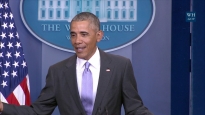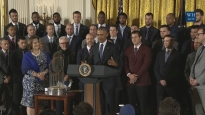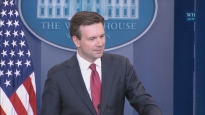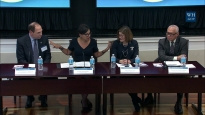President Obama on Urban Policy
July 14, 2009 | 13:57
The White House Office of Urban Affairs and the Domestic Policy Council host a roundtable about the future of America's urban and metropolitan areas. In his remarks, the President addresses some of the challenges facing these communities, and highlights innovative solutions. July 13, 2009. (Public Option)
Remarks by the President at Urban and Metropolitan Roundtable
THE WHITE HOUSE
Office of the Press Secretary
_________________________________________________________________________
For Immediate Release July 13, 2009
REMARKS BY THE PRESIDENT
AT URBAN AND METROPOLITAN POLICY ROUNDTABLE
Office of the Press Secretary
_________________________________________________________________________
For Immediate Release July 13, 2009
REMARKS BY THE PRESIDENT
AT URBAN AND METROPOLITAN POLICY ROUNDTABLE
Room 350
Eisenhower Executive Office Building
4:10 P.M. EDT
THE PRESIDENT: Hello, everybody. (Applause.) A couple of quick acknowledgments. Where's Greg -- where's Greg Nickels? There you are, Greg. Thank you so much for your participation today.
Eisenhower Executive Office Building
4:10 P.M. EDT
THE PRESIDENT: Hello, everybody. (Applause.) A couple of quick acknowledgments. Where's Greg -- where's Greg Nickels? There you are, Greg. Thank you so much for your participation today.
I understand Governor Rendell is here, or was here. He may have stepped out, but when he comes back in, I hope to have a chance to say hello to him.
Burrell Ellis, CEO of DeKalb County -- it's so nice to see you, Burrell. Kathie Novak -- where's Kathie? Hey, Kathie, good to see you. Henry Cisneros -- where are you? The legendary -- (laughter) -- good to see you, my friend. Federico Pena, thank you so much -- who worked so hard to help us get elected. Julia Stasch -- where's my friend from Chicago? There she is. Good to see you, Julia. And obviously you know our outstanding Cabinet that is so focused on these issues -- Ray LaHood, Shaun Donovan, Lisa Jackson. Where's -- Ms. Mills, there. Great to see Karen, and Hilda Solis.
I just want you to know, as well as our new director of our office of -- I always forget the full name of this -- I call it the Drug Czar, but -- (laughter.)
MR. KERLIKOWSKE: I'm fine with that. (Laughter.)
THE PRESIDENT: Okay, Gil. By the way, Nickels vouched for you. (Laughter.)
Thank you so much, all of you, for participating. I see a lot of friends, old and new. And it's great to be back and it's great to be joined by some of the finest urban thinkers in America for what I understand has been a critical conversation on the future of America's urban and metropolitan areas.
Now, as you might imagine, this is a subject that's near and dear to my heart. I've lived almost all my life in urban areas. Michelle and I chose to raise our daughters in the city where she grew up. And even though I went to college in LA and New York, and law school across the river from Boston, I received my greatest education on Chicago's South Side, working at the local level to bring about change in those communities and opportunities to people's lives.
And I see a number of Chicago folks who were fighting with me -- I mean, alongside me -- (laughter) -- for many years. I already mentioned Julia, but obviously there are a number of other folks, as well.
And that experience also gave me an understanding of some of the challenges facing city halls all across the country. And I know that those challenges are particularly severe today because of this recession. Four in five cities have had to cut services, just when folks need it the most, and 48 states face the prospects of budget deficits in the coming fiscal year.
And that's one reason why we took swift and aggressive action in the first months of my administration to pull our economy -- (Teleprompter screen falls) -- oh, goodness, sorry about that, guys -- (laughter) -- to pull our economy back from the brink, including the largest and most sweeping economic recovery plan in our nation's history. If we had not taken that step, our cities would be in a even deeper hole, and state budget deficits would be nearly twice as large as they are right now, and tens of thousands of police officers and firefighters and teachers would be out of a job as we speak. And I think that all of you are aware of that.
But what's also clear is we're going to need to do more than just help our cities weather the current economic storm. We've got to figure out ways to rebuild them on a newer, firmer, stronger foundation for our future. And that requires new strategies for our cities and metropolitan areas that focus on advancing opportunity through competitive, sustainable, and inclusive growth. And that's why all of you are here today. And I know that there were a lot of ideas that were shared throughout the morning and afternoon.
Now, the first thing we need to recognize is that this is not just a time of challenge for America's cities; it's also a time of great change. Even as we've seen many of our central cities continuing to grow in recent years, we've seen their suburbs and exurbs grow roughly twice as fast -- that spreads homes and jobs and businesses to a broader geographic area. And this transformation is creating new pressures and problems, of course, but it's also opening up new opportunities, because it's not just our cities that are hotbeds of innovation anymore, it's our growing metropolitan areas.
And when I spoke to the U.S. Conference of Mayors last year, I tried to hone in on this point that what I think traditionally had been seen as this divide between city and suburb, that in some ways you've seen both city and suburb now come together and recognize they can't solve their problems in isolation; they've got to paying attention to each other. And these metropolitan areas, they're home to 85 percent of our jobs and 90 percent of our economic output.
Now, that doesn't mean investing in America comes at the expense of rural America; quite the opposite. Investing in mass transit and high-speed rail, for example, doesn't just make our downtowns more livable; it helps our regional economies grow. Investing in renewable energy doesn't just make our cities cleaner; it boosts rural areas that harness that energy. Our urban and rural communities are not independent; they are interdependent.
So what's needed now is a new, imaginative, bold vision tailored to this reality that brings opportunity to every corner of our growing metropolitan areas -- a new strategy that's about Southern Florida as much as Miami; that's about Mesa and Scottsdale as much as it's about Phoenix; that's about Aurora and Boulder and Northglenn as much as about Denver.
An early step was to appoint Adolfo Carrion as our first White House Director of Urban Affairs. And his team and he share my belief that our cities need more than just a partner -- they need a partner who knows that the old ways of looking at our cities just won't do. And that's why I've directed the Office of Management and Budget, the Domestic Policy Council, the National Economic Council, and the Office of Urban Affairs to conduct the first comprehensive interagency review in 30 years of how the federal government approaches and funds urban and metropolitan areas so that we can start having a concentrated, focused, strategic approach to federal efforts to revitalize our metropolitan areas.
And we're also going to take a hard look at how Washington helps or hinders our cities and metro areas -- from infrastructure to transportation; from housing to energy; from sustainable development to education. And we're going to make sure federal policies aren't hostile to good ideas or best practices on the local levels. We're going to put an end to throwing money at what doesn't work -- and we're going to start investing in what does work and make sure that we're encouraging that.
Now, we began to do just that with my budget proposal, which included two investments in innovative and proven strategies. I just want to mention these briefly. The first, Promise Neighborhoods, is modeled on Geoffrey Canada's successful Harlem Children's Zone. It's an all-encompassing, all-hands-on-deck effort that's turning around the lives of New York City's children, block by block. And what we want to do is to make grants available for communities in other cities to jumpstart their own neighborhood-level interventions that change the odds for our kids.
The second proposal we call Choice Neighborhoods -- focuses on new ideas for housing in our cities by recognizing that different communities need different solutions. So instead of isolated and monolithic public housing projects that too often trap residents in a cycle of poverty and isolate them further, we want to invest in proven strategies that actually transform communities and enhance opportunity for residents and businesses alike.
But we also need to fundamentally change the way we look at metropolitan development. For too long, federal policy has actually encouraged sprawl and congestion and pollution, rather than quality public transportation and smart, sustainable development. And we've been keeping communities isolated when we should have been bringing them together.
And that's why we've created a new interagency partnership on sustainable communities, led by Shaun Donovan, as well as Ray LaHood and Lisa Jackson. And by working together, their agencies can make sure that when it comes to development -- housing, transportation, energy efficiency -- these things aren't mutually exclusive; they go hand in hand. And that means making sure that affordable housing exists in close proximity to jobs and transportation. That means encouraging shorter travel times and lower travel costs. It means safer, greener, more livable communities.
So we're off to a good start. But the truth is, is that Washington can't solve all of these problems that face our cities, and frankly, I know that cities don't expect Washington to solve all these problems. Instead of waiting for Washington, a lot of cities have already gone ahead and become their own laboratories for change and innovation, some leading the world in coming up with new ways to solve the problems of our time.
So you take an example like Denver. Their metropolitan area is projected to grow by 1 million residents over the next 15 years or so. But rather than wait for a congestion crisis, they're already at work on plans to build and operate a public transit system up to the challenge, and to surround that system with smart new housing, retail, and office development near each stop.
Philadelphia is an example of what's been called "urban agriculture." It may sound like an oxymoron, but one proposal is trying to make a situation where fresh, local food supplies are within a short walk for most city residents, which will have a direct impact not only on the economy and on the environment, but also make an immeasurable difference in the health of Americans.
Or Kansas City. One idea there focuses on transforming a low-income community into a national model of sustainability by weatherizing homes and building a green local transit system.
Three different cities with three unique ideas for the future. And that's why they're three of the cities that are members of my -- that members of my Cabinet and Office of Urban Affairs will visit this summer as part of a ongoing national conversation to lift up best practices from around the country, to look at innovations for the metropolitan areas of tomorrow. Forward-looking cities shouldn't be succeeding despite Washington; they should be succeeding with a hand from Washington. We want to hear directly from them, and we want to hear directly from all of you, on fresh ideas and successful solutions that you've devised, and then figure out what the federal government should do or shouldn't do to help reinvent cities and metropolitan areas for the 21st century.
So I know that this change is possible. After all, I'm from a city that knows a little something about reinventing itself. In the 19th century, after a cataclysmic fire, Chicagoans rebuilt stronger than before. In the last century, they led the world upward in steel and glass. And in this century, under my friend Mayor Daley's leadership, they're helping to lead the world forward in newer, greener, more livable ways.
Daniel Burnam said, "Make no little plans." And that's the spirit behind his bold and ambitious designs unveiled 100 years ago this month that helped transform Chicago into a world-class city. That's the same spirit which we have to approach the reinvention of all America's cities and metropolitan areas -- a vision of vibrant, sustainable places that provide our children with every chance to learn and to grow, and that allow our businesses and workers the best opportunity to innovate and succeed, and that let our older Americans live out their best years in the midst of all that metropolitan life can offer. Now is the time to seize that moment of possibility, and I am absolutely confident that, starting today with this conversation, you and I together, we're going to be able to make this happen.
Daniel Burnam said, "Make no little plans." And that's the spirit behind his bold and ambitious designs unveiled 100 years ago this month that helped transform Chicago into a world-class city. That's the same spirit which we have to approach the reinvention of all America's cities and metropolitan areas -- a vision of vibrant, sustainable places that provide our children with every chance to learn and to grow, and that allow our businesses and workers the best opportunity to innovate and succeed, and that let our older Americans live out their best years in the midst of all that metropolitan life can offer. Now is the time to seize that moment of possibility, and I am absolutely confident that, starting today with this conversation, you and I together, we're going to be able to make this happen.
So thank you for joining us, and I'm looking forward to all of us getting to work. Thank you. (Applause.)
END 4:21 P.M. EDT
|
January 18, 2017
|
January 17, 2017
|
January 16, 2017
|
January 16, 2017
|
|
January 14, 2017
|
January 13, 2017
|
January 13, 2017
|
January 12, 2017
|







